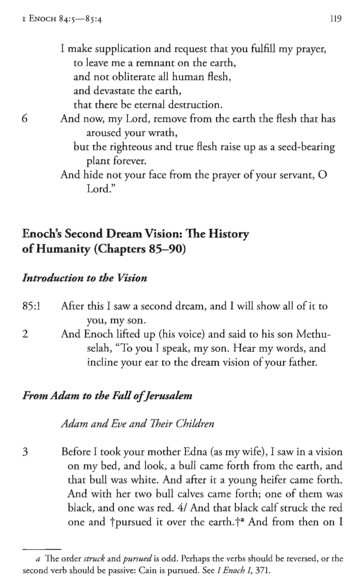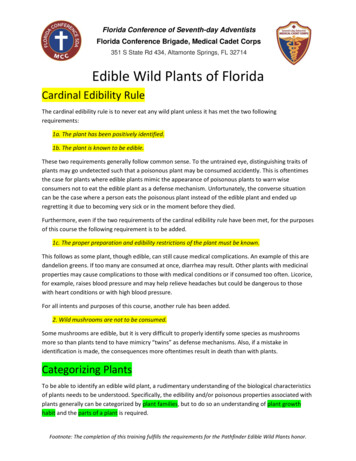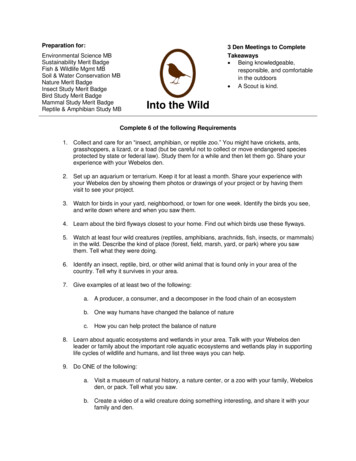
Transcription
Preparation for:Environmental Science MBSustainability Merit BadgeFish & Wildlife Mgmt MBSoil & Water Conservation MBNature Merit BadgeInsect Study Merit BadgeBird Study Merit BadgeMammal Study Merit BadgeReptile & Amphibian Study MB3 Den Meetings to CompleteTakeaways Being knowledgeable,responsible, and comfortablein the outdoors A Scout is kind.Into the WildComplete 6 of the following Requirements1. Collect and care for an “insect, amphibian, or reptile zoo.” You might have crickets, ants,grasshoppers, a lizard, or a toad (but be careful not to collect or move endangered speciesprotected by state or federal law). Study them for a while and then let them go. Share yourexperience with your Webelos den.2. Set up an aquarium or terrarium. Keep it for at least a month. Share your experience withyour Webelos den by showing them photos or drawings of your project or by having themvisit to see your project.3. Watch for birds in your yard, neighborhood, or town for one week. Identify the birds you see,and write down where and when you saw them.4. Learn about the bird flyways closest to your home. Find out which birds use these flyways.5. Watch at least four wild creatures (reptiles, amphibians, arachnids, fish, insects, or mammals)in the wild. Describe the kind of place (forest, field, marsh, yard, or park) where you sawthem. Tell what they were doing.6. Identify an insect, reptile, bird, or other wild animal that is found only in your area of thecountry. Tell why it survives in your area.7. Give examples of at least two of the following:a. A producer, a consumer, and a decomposer in the food chain of an ecosystemb. One way humans have changed the balance of naturec.How you can help protect the balance of nature8. Learn about aquatic ecosystems and wetlands in your area. Talk with your Webelos denleader or family about the important role aquatic ecosystems and wetlands play in supportinglife cycles of wildlife and humans, and list three ways you can help.9. Do ONE of the following:a. Visit a museum of natural history, a nature center, or a zoo with your family, Webelosden, or pack. Tell what you saw.b. Create a video of a wild creature doing something interesting, and share it with yourfamily and den.
1: Collect and care for an “insect, amphibian, or reptile zoo.”If a boy has an ant farm or other insect habitat at home, he can use it to help him complete thisrequirement. Otherwise, he will need to trap and keep an insect for a short period of time, then release itback into the wild. It is recommended he capture a larger insect like a beetle or grasshopper.Cubs can work on a craftsman project by building a simple insect cage with the following materials:2 Tuna Cans (or cans of similar size)1 square Embroidery Mesh1 plastic bottle cap3 metal brads1 green stick with leavesInstructions:1. Using a drop of hot glue or a glue dot, adhere the bottlecap inside one of the tuna cans on the bottom.2. Wrap the embroidery mesh around the inside of thesecond tuna can, allowing ½ inch of overlap. Trim offany excess.3. Use the metal brads to hold the mesh together at theoverlap.4. Tape or glue the mesh inside the tuna can by tapingaround the outside of the can.5. Catch an insect on the green stick with leaves andcarefully insert the stick into the mesh. Fill the bottlecap with water, then insert the mesh into the secondtuna can, being careful not to spill the water.The stick and leaves will be the insect’s food, and the bottle cap will be its water. This will keep the insectalive for a few days before the stick needs to be replaced or the insect needs to be released.
2. Set up an Aquarium or TerrariumThe Webelos Scout will need to keep this Aquarium or Terrarium for one month. A fish bowl will work forthis, but he will likely enjoy a full aquarium. This is obviously something his parents will need to help himput together and complete.
3. Watch for Birds in Your Yard, Neighborhood or Town for One Weekhttp://www.utahbirds.org/House FinchBlack-billed MagpieHouse SparrowCalifornia QuailPine Siskin
4. Learn About the Bird Flyways Closest to Your Home
Birds and Great Salt LakeGreat Salt Lake supports between 2 and 5 million shorebirds, as many as 1.7 million eared grebes, andhundreds of thousands of waterfowl during spring and fall migration. Because of its importance tomigratory birds, the lake was designated a part of the Western Hemisphere Shorebird Reserve Network in1992. The lake and its marshes provide a resting and staging area for the birds, as well as an abundanceof brine shrimp and brine flies that serve as food.SpeciesPopulationRemarksWilson's Phalarope500,000Largest staging concentration in the worldRed-Necked Phalarope280,000Single-day estimateAmerican Avocet250,000Many times higher than any other wetland in thePacific FlywayBlack-Necked Stilt65,000Many times higher than any other wetland in thePacific FlywayMarbled Godwit30,000Single-day countSnowy Plover10,000The worlds largest assemblage, representing 55% ofthe entire breeding population west of the Rocky Mts.Western Sandpiper17,000In one flockLong-Billed Dowitcher32,000Single-day countWhite Pelican18,000Breeding adults, one of the three largest colonies inWestern North AmericaWhite-Faced Ibis7,500Breeding adults, world's largest breeding populationCalifornia Gull160,000Breeding adults, world's largest breeding populationEared Grebe400,000Second largest staging population in North AmericaPeregrine FalconBald EagleBank Swallow11 500 10,000Active pairs of this endangered speciesWintering Eagles associated with Great Salt Lake, oneof top 10 winter populations in the lower 48 statesIn one flock. Great Salt Lake represents one of thelargest migratory corridors in Western North AmericaSource: Utah Division of Wildlife Resources, Don Paul
5. Watch Four Wild Animals in the WildWatching animals in the wild with a bunch of noisy Webelos can be difficult. Finding a local wildlifesanctuary can provide you with a more structured way to observe the animals. The followingsanctuaries/preserves are in our area:Great Salt Lake Nature Centerhttp://wildlife.utah.gov/gslnc-home.htmlThe nature center is located along the southeast shore of the Great Salt Lake, adjacent to the UtahDivision of Wildlife Resources' Farmington Bay Waterfowl Management Area (WMA). Up to five millionbirds of over 200 species visit Farmington Bay each year.Farmington Bay Waterfowl Management Areahttp://wildlife.utah.gov/habitat/farmington bay.phpHundreds of thousands of waterbirds, songbirds and raptors visit this area during the migration andnesting seasons. More than 200 different species have been documented on the management area.Antelope Island State d-state-parkAntelope Island is home to free-ranging bison, mule deer, bighorn sheep, pronghorn antelope, and manyother desert animals.
6. Identify an insect, reptile, bird, or other wild animal that is foundonly in your area of the country.Hogle Zoo: http://www.hoglezoo.org/meet our animals/animal finder/animals-native-to-utah/Utah Conservation Data Center: http://dwrcdc.nr.utah.gov/ucdc/7a. A producer, a consumer, and a decomposer in the food chain ofan ecosystem
8. Learn about aquatic ecosystems and wetlands in your area.We might look at swamps, marshes, or otherwetlands and think they look really dirty andmaybe even gross. Wetlands are an importanthabitat for Utah because they help duringflooding (plants absorb water and slow themovement of flood waters), and the plants andanimals also act as a filter in keeping out silt (atype of sediment) as well as pollution. Howdoes this help us? Well, it means that thingsthat might get into our water we use are keptout and keep us safe!Fun Facts about Wetlands: They are an important part of keeping temperatures at a good level-75% of Utah's wetlands are a part of the Great Salt Lake ecosystem-The Great Salt Lake is a very important habitat for birds to live.Wetland n bay.phpFarmington Bay hosts an array of wetland habitats including fresh water ponds, marshes, expansive flatsand open salt water. These diverse wetland types are vital habitats for a diversity of wildlife along theGreat Salt lake.Fresh-water and brackish marshes support vegetation such as cattail, hardstem and alkali bulrush,saltgrass and pondweed. These are important because of the food and protective cover they provide forwildlife. An abundance of protein-rich invertebrates such as insect larvae provide important food for veryyoung birds. Several species of fish also live in the ponds and provide food for fish-eating birds such asgreat blue herons and American white pelicans.Saline mud flats support a range of salt tolerant plants known as halophytes. Salicornia, commonly calledpickle weed, is a plant found commonly on these flats. This halophyte produces seeds that are consumedby migrating waterfowl as well as other species. The sensitive western snowy plover nests on the salineflats at Farmington Bay.The open salt water habitat is too salty for fish but is teaming with two invertebrates; brine shrimp andbrine flies. Eared grebes and Wilson's phalaropes are two of the many species that consume largequantities of these invertebrates during migration.
9a. Visit a museum of natural history, a nature center, or a zooNATURAL HISTORY MUSEUM of UTAH WALK PATCHRequirements:With your den, pack or family, visit the Natural History Museum of Utah.Start on Level 5 and work your way down to complete 10 of the followingrequirements to earn this patch. Patches may be purchased at the localScout Shop.Native Voices Gallery1.Look for stories of urban Indians on the north wall of the gallery. Ceceilia Tso is a Navajoeducator who lives in Salt Lake City and works at the University of Utah. How many differenttribes does she say are represented in urban areas along the Wasatch Front?Sky Gallery2.We usually see lightning in the sky, but can you find its “petrified” remains in this gallery? What isthe scientific name of the fused glass tubes created by lightning strikes?Life Gallery3.All living organisms are made up of one or more cells. Using the interactive plant and animalcells, name one part that is similar and one that is different between the two cells.4.Using one of the dioramas that depict five of Utah’s ecosystems, create a food chain with at leastfour organisms.Land Gallery5.Visit the sand dune interactive. Describe what happens when you change the direction of thewind.6.Try your hand at building an earthquake proof structure at the Earthquake Table. Did yourstructure stand up to the test? If not, redesign and try again.First Peoples Gallery7.Visit the Median Village excavation site and explore the artifacts and photos on the rail around it.Why is mapping a site so important to archaeological work?8.Making pottery in prehistoric Utah required skill and knowledge. Find a case that explains theprocess of making pottery. What was one technique potters used to decorate their work?Lake Gallery9.The north arm of the Great Salt Lake is separated from the south arm by a causeway built in1959. What extremophile thrives in the ultra-salty water of the north arm in such numbers thatthey can turn the water pink?
10. Investigate the wetlands exhibit and describe what you observe when you pull the lever in the‘Filter Flow’ interactive. How do wetlands help to clean the water?Past Worlds Gallery11. Find the four video screens behind the giant long-necked Barosaurus. Listen to thepaleontologists’ different ideas about why there are so many fossils buried together at theCleveland Lloyd Dinosaur quarry in eastern Utah. Which hypothesis is most convincing to youand why?12. Visit the skeleton of a single dinosaur under glass in the floor. Find the fossilized dinosaur skinimprint you can touch on the wall nearby. You’ve just connected with the largest dinosaur thatlived in Utah in the Late Cretaceous period about 76 million years ago. What is its name?Earth Lab and Paleontology Lab13. Visit the Earth Lab and locate the mineral drawers. Gently take out a few of the Utah-specificmineral drawers. Describe your favorite mineral and explain why it’s your favorite.14. When dinosaur bones are found in the field, they are removed from the matrix and transportedback to the Museum wrapped in a plaster jacket. What do these jackets remind you of?Visit www.nhmu.utah.edu to plan your visit!Open Daily 10:00 a.m. to 5:00 p.m.Wednesdays 10:00 a.m. to 9:00 p.m.Located at 301 Wakara Way, Salt Lake City
CUB ZOO TRAIL PATCHWith your den, pack, or family go to the Hogle Zoo and complete the followingrequirements to earn this patch:1. Identify 20 different animals2. Determine which parts of the world these animals originated. (Notice thesigns at each exhibit for this information.)3. Tour and observe Hogle Zoo with your family or den.4. WEAR YOUR UNIFORM.Open year-round except on Christmas and New Year's DayHours: 9:00 a.m. to 5:00 p.m.Plan Ahead - You must call Hogle Zoo, (801) 584-1785, two weeks before you plan to attend in order toreceive the group discount and the Hogle Zoo brochure. When you call be prepared to leave a messagewith the following information: Your name, mailing address, phone number, date of visit, and approximatenumber of people attending.Group must have at least 20 individuals to qualify for discount.Location: 2600 E Sunnyside Ave, Salt Lake CityAdmission:Without Discount - 8.00 per Adult, 6.00 per BoyWith Discount - 7.00 per Adult, 5.00 per BoyThis patch may be purchased at a local Scout Shop.
5. Watch at least four wild creatures (reptiles, amphibians, arachnids, fish, insects, or mammals) in the wild. Describe the kind of place (forest, field, marsh, yard, or park) where you saw them. Tell what they were doing. 6. Identify an insect, reptile, bird, or other wild animal that is found only in your area of the country.


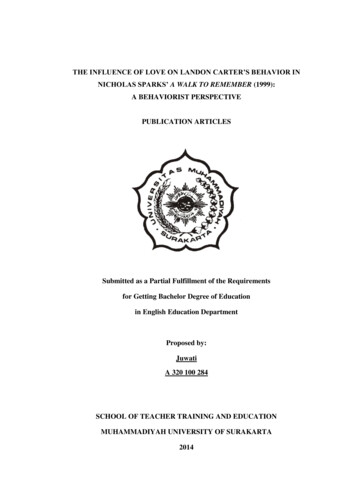
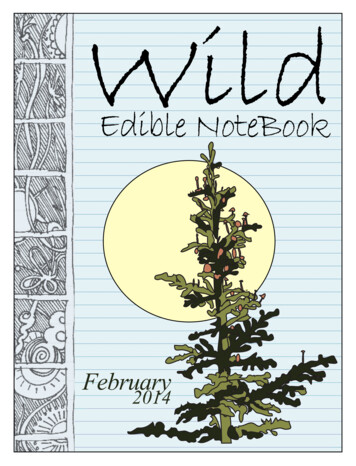
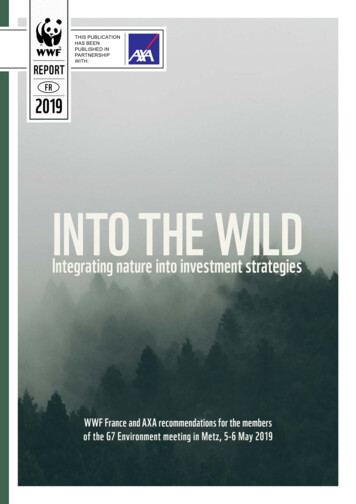


![INDEX [randycherry ]](/img/21/x-20-20tv-20fakebook-20-20hal-20leonard.jpg)
